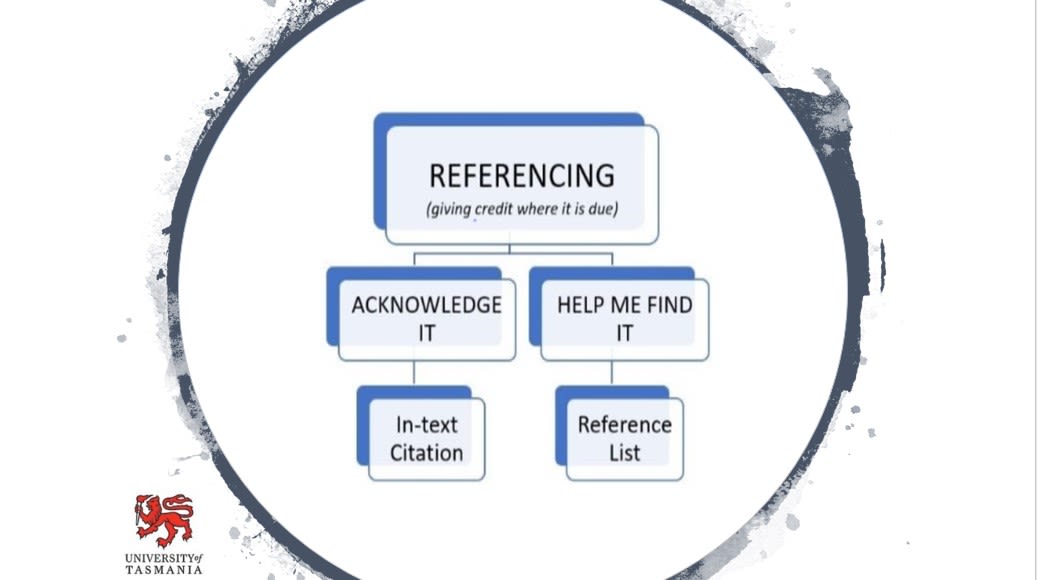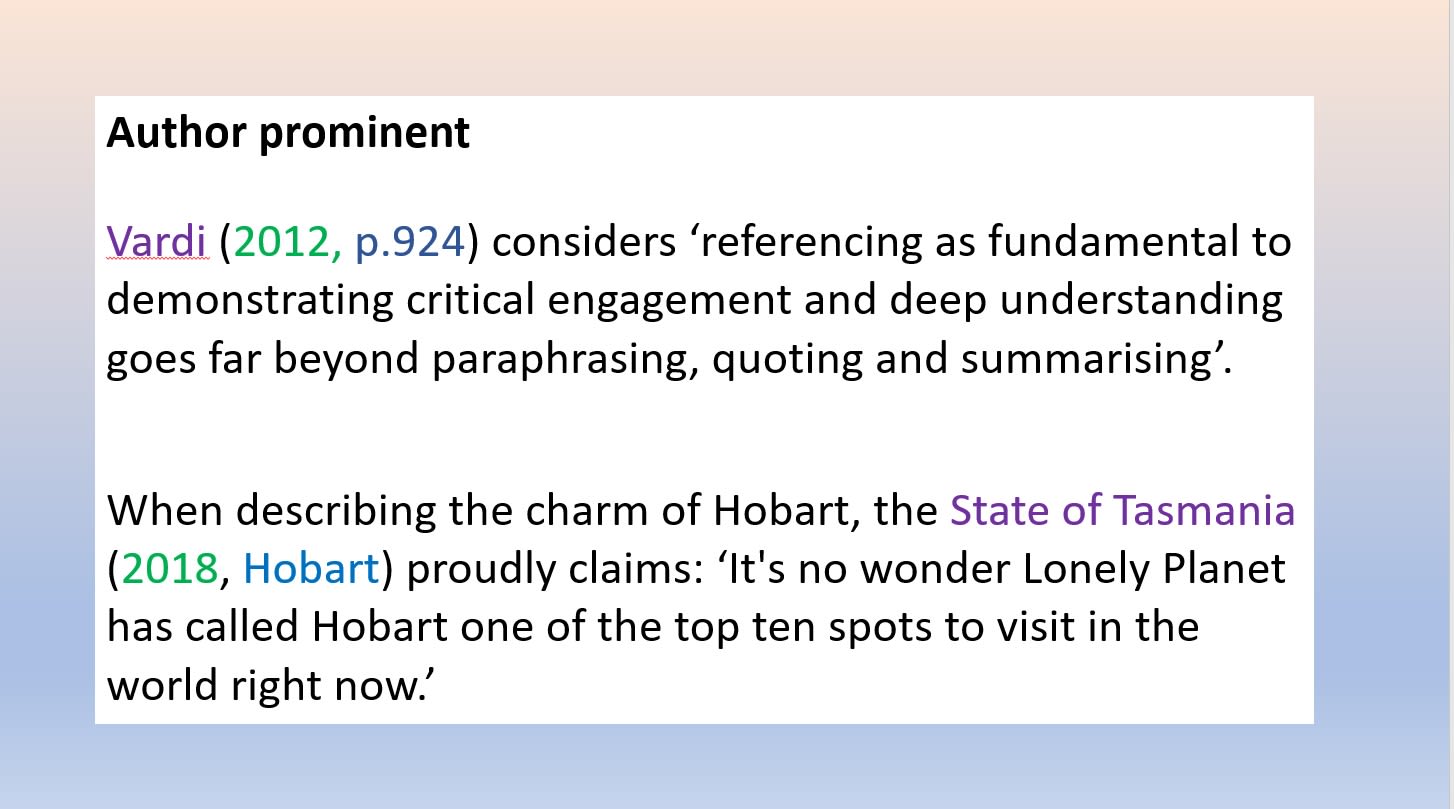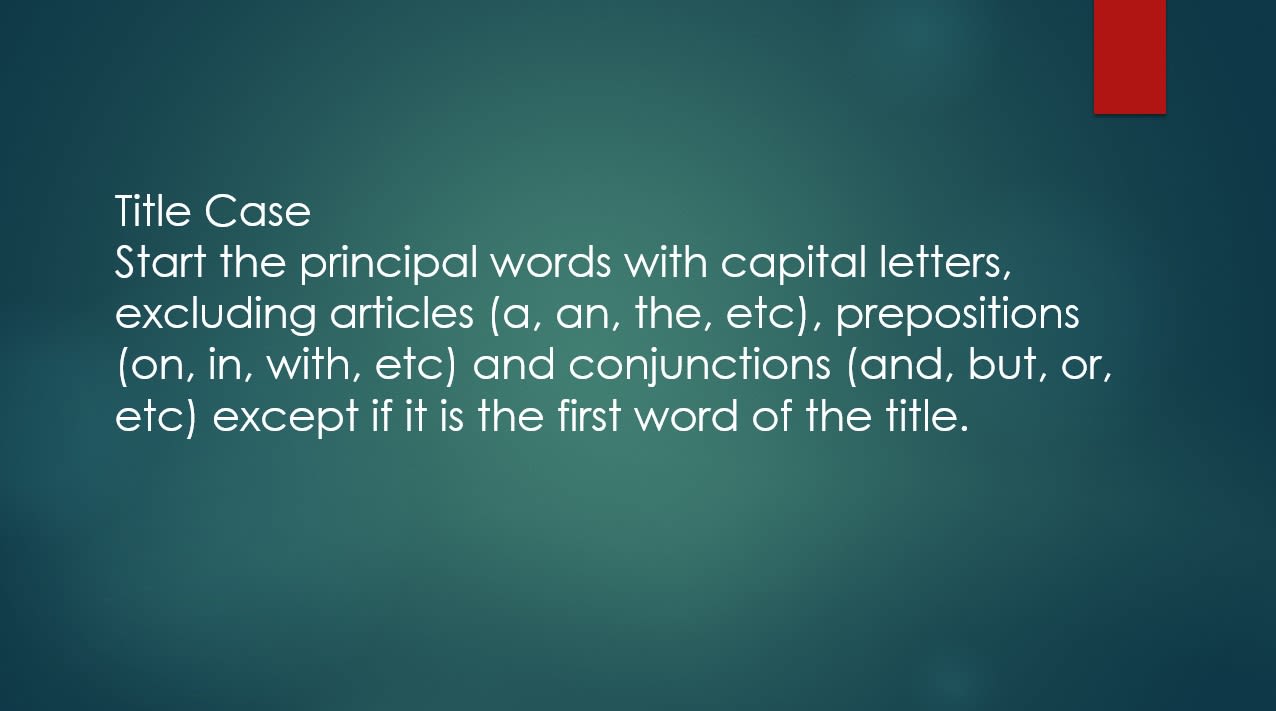Simplified
Author-date &
Writing guide

Author-Date system includes in-text citations (also known as abbreviated references) and a reference list at the end of the document. In addition, when using direct quotes or a block quote, you MUST also provide specific detail (e.g. page number) about where the information is located within the source.
"Scholarship involves researching, understanding, and building upon the work of others. It requires that credit is given where it is due and the contributions of others in our intellectual efforts are acknowledged appropriately."
Golden Rule: Acknowledge it & help me find it!

When and how do I include sources?
There are two ways to incorporate ideas from your research into your own writing. The key is to make sure that it is easy for the reader to see where you are stating your own ideas and where you are presenting ideas from your research – your in-text citation will help to do this.
A good idea is to take a look at the sources you are reading in each unit. Do they mostly use author prominent or subject prominent citations?
What is an ‘author prominent’ citation?
In author prominent citations, the writer’s name is used as part of your sentence. The rest of the citation (the when and where) is placed in brackets immediately after the author’s name. Author prominent citations are often preceded by phrases such as ‘according to…’ or ‘a study by’; they are often followed by reporting verbs such as discuss, show, and argue.
E.g.
According to Petric (2012)…
A study by Petric (2012) found that…
Petric (2012) argues that/shows that…
Petric (2012) discusses…
To learn more about how to use reporting verbs effectively in your writing, refer to: https://warwick.ac.uk/fac/soc/al/globalpad/openhouse/academicenglishskills/grammar/reportingverbs/
When should I choose author prominent citations?
Author prominent citations highlight the people or organisation who wrote the words or did the research. For this reason, they are often used when ideas are new, debatable, or subjective, or when the author is famous or important.


Subject prominent
In subject prominent citations, the information from your research is presented first, with the in-text reference at the end of the sentence.
E.g.
The most common form of dementia is Alzheimer's disease, which is thought to be a factor in about two thirds of cases (World Health Organisation 2019).
When should I choose subject prominent citations?
Subject prominent citations highlight the information, research and ideas, (rather than the people) who produced them. For this reason, they are often used when ideas are well established, or can be objectively proven or tested.
Subject prominent citations may be more commonly used when presenting facts and figures, or the results of research.


Direct Quotes
For short quotations (up to 30 words), follow the same rules as paraphrasing/summarising but add a page number.
If no page number is available (e.g. some online sources), use another way to identify the place of the quote within the text, such as a paragraph number (only if numbered), the heading, or the document title (shortened, if necessary).
Include single quotation marks around the text.


Block quotes
Quotes that are more than 30 words should appear as a block of free-standing text.
Indent the quote and reduce the font by one size.
Do not include quotation marks.



Referring to information from the same source in consecutive sentences

There is no need to repeatedly include an in-text citation when referring to the same source in consecutive sentences. Just ensure that you make it clear (through the pronoun or possessive adjectives) that you are still referring to the same source.
Note:
- The third sentence uses the author’s name as part of the narrative but this sentence does not require a full in-text citation.
- If you include a direct quote, you must include an in-text citation.


Common Knowledge
Common knowledge generally refers to facts that are considered widely known, i.e. information that most people would know or can be easily verified. Common knowledge can relate to information within a particular country/region, religious group, or discipline at university, etc.
E.g. ‘The University of Tasmania is the only university in Tasmania’ could be considered common knowledge for people living in Tasmania, but it may not be common knowledge to people in other Australian states or other countries.
Questions to ask yourself
- Is this someone’s opinion, evaluation, interpretation, results from their study, a definition or a statistic? If the answer is yes, then it is not common knowledge. e.g. “University of Tasmania is placed in the top 2% of universities worldwide” - the source of this information needs to be cited.
- Can this be quickly verified by at least 3 different reliable sources? A quick search can confirm that there is only 1 university in Tasmania, therefore this would not need to be cited.
- Who is my audience? At university, certain information may be considered common knowledge within a discipline. Stalnaker (2002, p.701) describes it as “presumed background knowledge shared by participants in a conversation”. Determining what information qualifies as common knowledge is a difficult skill, but as a starting point, has this information been stated in a lecture or covered in your textbook / required readings?
If in doubt, cite it!
The sample paragraph below starts with a broad statement that introduces the topic, provided the content was covered in a lecture or textbook this may be considered common knowledge (an unsupported fact/statement). When using common knowledge (unsupported facts/statements) in an essay, it needs to be supported by additional information (supported facts/statements) these sources should be cited in-text.



What type of sources only require an in-text citation?

The following reference types are only cited in-text; they do not need to be included in a reference list.
- Legislation
- Court cases
- Personal communication
The citation systems used by the legal profession are quite different from most other citation styles. The legal styles used in Australia also differ from the ones used in other jurisdictions, e.g. USA, Canada, UK, EU. For Australia, use the following guidelines; for other jurisdictions, reproduce the name of the source exactly as shown or seek assistance from a librarian.

Legislation (Acts, Regulations, Rules, By-laws, Bills, etc)
- Use Title Case.
- Italicise titles and years (except for Bills).
- Show the jurisdiction (Cth, ACT, NSW, NT, Qld, SA, Tas, Vic, WA) unless it is obvious from the title.
E.g.
Housing Land Supply Act 2018 (Tas) s 10
South Australian Productivity Commission Bill 2018
Marine Safety Regulations 2012 (Vic)
A New Tax System (Goods and Services Tax) Act 1999 (Cth)
Australian Constitution s 44
Court decisions/Judgments/Cases
- Italicise the names of the parties.
- Copy the remaining information as it appears in the source, including the brackets and parentheses.
E.g.
Zaburoni v The Queen (2016) 256 CLR 482
Commonwealth v Tasmania ("Tasmanian Dam case") [1983] HCA 21
Clarence City Council v Resource Management and Planning Appeal Tribunal (No 2) [2018] TASSC 51
Personal communication
Email, personal interviews, letters, telephone conversations, public lectures, etc, and other sources where the information is not obtainable by others
- Give the initial/s and surname of the communicator and the exact date
- Use the abbreviation pers. comm. if it is unclear from the sentence that you are referring to a personal communication.
e.g.
Mr C Black confirmed that… (29 Jan 2019, pers. comm.).
In an interview on 9 April 2018, Ms R White stated that…










How do I format the reference list?
- Start the reference list on a new page.
2. Order alphabetically by author’s name;
a) If there is more than one source by the same author, list chronologically from oldest to newest; year precedes exact date (see Doe).
b) If the sources have the same year, 2018a precedes 2018b (see Tarulevicz)
c) A source with a single author precedes a source with the same first author with additional authors (see Ferguson).
d) Alphabetise prefixes that form part of the family name such as O’Brian, MacDonald & Fitzroy as cited, therefore
- MacDonald precedes
- M’Arthur, which precedes
- McDonald.
e) Prefixes such as van/de/von that appear separate from the family name, place in front of family name but do not capitalise; arrange alphabetically by the family name.
E.g. du Pont, PS, place alphabetically under Pont.
3. If reference goes onto a new line, add hanging indent of 1cm.
Note: The URL font size can be reduced by 1 or 2 points to keep it on the same line as the rest of the reference.
4. Line spacing = 2.0 (double)
5. Add appendices, on a new page after the reference list.
See example reference list below
NOTE: Do not rely on Endnote or any other citation generator to format your references perfectly, always check the style guide.

Additional resources
There are several units within MyLo that can provide additional information on developing your academic writing.
- Academic and study skills development
- Turnitin & academic writing
- Scientific communication skills - Scribble & Babble
To find these non award units. Click on 'Discover Course Catalog' on the MyLo home page.

The Study Support & Resources page will help you find out more about the services available to you on-campus or online.


